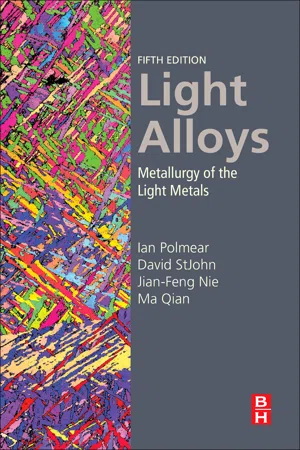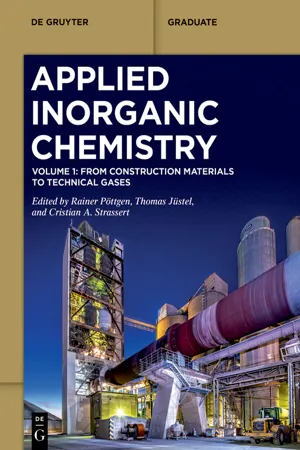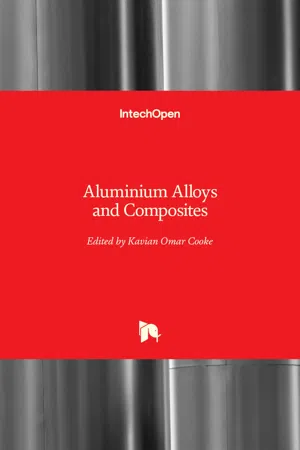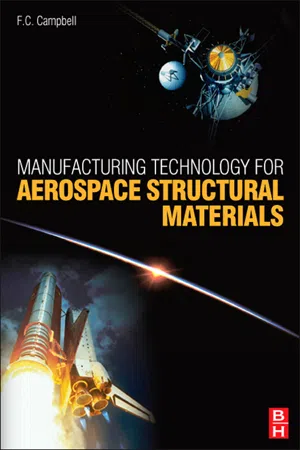Technology & Engineering
Light Alloys
Light alloys are metallic materials with low density, typically composed of aluminum, magnesium, and titanium. They are valued for their high strength-to-weight ratio, making them suitable for applications where weight reduction is critical, such as in aerospace, automotive, and sporting equipment. These alloys offer excellent corrosion resistance and are easily formable, making them versatile in various engineering and manufacturing processes.
Written by Perlego with AI-assistance
Related key terms
1 of 5
8 Key excerpts on "Light Alloys"
- Zaki Ahmad(Author)
- 2015(Publication Date)
- IntechOpen(Publisher)
Section 1 Development of Light Alloys Chapter 1 Light Alloys — From Traditional to Innovative Technologies Ildiko Peter and Mario Rosso Additional information is available at the end of the chapter http://dx.doi.org/10.5772/60769 Abstract Selection of materials with the expected, application-dependent characteristics constitutes a very important point in any industrial application. In the automotive and aeronautical industries, the current tendency is to use light metals and their alloys for production of various components. For example, some of the problems related to fuel consumption and weight reduction could be partially solved by using such alloys as an alternative to traditional iron-based alloy components. Due to their very attractive properties, the most commonly employed light materials for producing high-stressed components are aluminium, magnesium and their alloys. Al-based alloys have a high strength/weight ratio, good formability, excellent combination of castability and mechanical properties which together with an excellent corrosion resistance make them very appropriate for a large variety of applications. There are two important families of aluminium alloys: (i) wrought alloys, firstly cast as ingots and/or billets and then mechanically hot- and/or cold-worked into the preferred shape, and (ii) cast alloys, directly cast into their final form through different traditional or innovative processes. At the same time, there is continuing interest in Mg alloys for engineering proposals because of their lowest density directly connected to a weight saving of about 40% compared to steel and cast iron and 20% compared to aluminium for the same component performance.- eBook - PDF
Light Alloys
From Traditional Alloys to Nanocrystals
- Ian Polmear(Author)
- 2005(Publication Date)
- Butterworth-Heinemann(Publisher)
1 THE LIGHT METALS 1.1 GENERAL INTRODUCTION The term ‘light metals’ has traditionally been given to both aluminium and mag-nesium because they are frequently used to reduce the weight of components and structures. On this basis, titanium also qualifies and beryllium should be included although it is little used and will not be considered in detail in this book. These four metals have relative densities ranging from 1.7 (magnesium) to 4.5 (tita-nium) which compare with 7.9 and 8.9 for the older structural metals, iron and copper, and 22.6 for osmium, the heaviest of all metals. Ten other elements that are classified as metals are lighter than titanium but, with the exception of boron in the form of strong fibres contained in a suitable matrix, none is used as a base material for structural purposes. The alkali metals lithium, potassium, sodium, rubidium and caesium, and the alkaline earth metals calcium and strontium are too reactive, whereas yttrium and scandium are comparatively rare. 1.1.1 Characteristics of light metals and alloys The property of lightness translates directly to material property enhancement for many products since by far the greatest weight reduction is achieved by a decrease in density (Fig. 1.1). This is an obvious reason why light metals have been associated with transportation, notably aerospace, which has provided great stimulus to the development of Light Alloys during the last 50 years. Strength: weight ratios have also been a dominant consideration and the central positions of the Light Alloys based on aluminium, magnesium and titanium with respect both to other engineering alloys, and to all materials are represented in an Ashby dia-gram in Fig. 1.2. The advantages of decreased density become even more impor-tant in engineering design when parameters such as stiffness and resistance to buckling are involved. - eBook - ePub
- Rainer Pöttgen, Thomas Jüstel, Cristian A. Strassert, Rainer Pöttgen, Thomas Jüstel, Cristian A. Strassert(Authors)
- 2022(Publication Date)
- De Gruyter(Publisher)
2.3 Metallic light-weight alloys: Al, Ti, Mg
M. BertauMetallic light-weight alloys are usually based on Al, Ti, Mg and Be as main constituents. The applications of the Be-based alloys are addressed separately in Chapter 2.7. Due to their low density and high weight to strength ratio, light-weight alloys are widely used in numerous areas of everyday life. Additionally, all of these are usually non-ferrous alloys with a low toxicity (except for Be), enabling their use in a plethora of applications.2.3.1 Aluminum-based alloys
2.3.1.1 Applications
Aluminum alloys are versatile materials that find application in almost every industrial and commercial sector. Especially the transport sector, e.g. automotive and commercial vehicle construction, rail vehicles (housing, brakes, etc.; Figure 2.3.1 ), as well as aerospace applications rely on these materials [1 , 2 ]. In the automotive industry, the need for weight reduction to achieve CO2 reduction goals along with increasing fuel prices have triggered a serious series of developments of these materials. For decades, the use of aluminum in the automotive industry was limited to molding applications in the drive system. However, the ability to fabricate motor blocks, heat exchangers or parts of the chassis from aluminum alloys have led to significant advances that have also transitioned to the field of commercial vehicles. The transportation sector has realized the advantages of aluminum alloys. Also, the fields of architecture, machine, apparatus and tool construction have employed various available aluminum-based alloys. One of the first attempts to use aluminum in architecture was in the construction of New York’s Empire State building between 1930 and 1931 [3 - eBook - ePub
Machining of Light Alloys
Aluminum, Titanium, and Magnesium
- Diego Carou, J. Paulo Davim, Diego Carou, J. Paulo Davim(Authors)
- 2018(Publication Date)
- CRC Press(Publisher)
one Light Alloys and their machinability A reviewMohd Danish , Turnad Lenggo Ginta , Muhammad Yasir , and Ahmad Majdi Abdul Rani1.1 Introduction1.2 Properties and applications1.2.1 Aluminum1.2.2 Magnesium1.2.3 Titanium1.3 Machinability of aluminum1.3.1 Cutting temperature1.3.2 Cutting forces1.3.3 Cutting tools1.3.4 Tool wear1.4 Machinability of magnesium1.4.1 Cutting temperature and ignition1.4.2 Cutting speeds1.4.3 Cutting tool1.4.4 Tool wear1.5 Machinability of titanium1.5.1 Cutting temperature1.5.2 Cutting forces1.5.3 Cutting tools1.5.4 Tool wear1.5.5 Chatter1.6 Cryogenic machining of Light Alloys1.7 ConclusionsReferences1.1 IntroductionThe use of Light Alloys or materials having low specific weight is critical in manufactured parts used in aerospace, automobiles, electronics, sports, and biomedical applications. Generally, the term “Light Alloys” is used for alloys having base material aluminum (Al), magnesium (Mg), and titanium (Ti) (Polmear 2005). The density of the part becomes a critical factor when it comes to automobiles and mainly in aerospace. This is due to the fact that weight has a direct relation with the economy of the aerospace and automobile industries. A lighter vehicle will require less power, and a less amount of fuel will be consumed. In case of the space shuttle, mass is more critical as gravitational pull will be more powerful toward the greater mass. Light Alloys have gained the attention of researchers around the globe because of not only their low density but also their other attractive properties, like the good machinability of magnesium, electrical and thermal conductivity of aluminum, and high corrosion resistance of titanium.Machining is widely used for manufacturing products used in various industries like aviation, automobiles, and biomedical. There is not a fixed definition of machinability of materials, but still, it can be defined as ease of the material to be machined to have the required shape and size. It can also be defined from the power consumption perspective and the morphology of the chips (Elgallad et al. 2010). However, machining is not easy when it comes to Light Alloys. This chapter will review the properties and the machinability of Light Alloys focusing mainly on aluminum-, magnesium-, and titanium-based alloys. A special section for cryogenic machining of Light Alloys is also presented in this chapter. - eBook - PDF
- Kavian Omar Cooke(Author)
- 2020(Publication Date)
- IntechOpen(Publisher)
With the advent of alloying technology, the use of aluminium was developed farther and positioned aluminium as the most utilised industrial metal for decades. The popularity of aluminium grew due to its good attributes related to its unique properties, mainly of light-weight combined with good thermal/electrical conduction and reasonably good strength and resistance to corrosion. With alloying, aluminium has found more applications than previously envisioned, making aluminium a serious competitor with (and sometimes a pre-ferred alternative to) the traditional “strong” metals iron and steel [3]. Aluminium alloys and composites have, in most applications, exhibited superior performance compared to their rival metals. The choice of aluminium alloys and composites derives from one important attribute of aluminium metal—light-weight. Light-weight translates into many important outcomes in engineering applications. In the automotive industry, it means less dead weight, lower fuel consumption, lower emissions, increased payload (for passengers and cargo) and easier handling. In the aerospace and aircraft industry, it translates into more payload (cargo), less fuel and lower emissions. There are similar advantages in all areas where aluminium is utilised—marine, rail, packaging, thermal management, building and construction, sports and recreation, etc. Aluminium’s good electri-cal and thermal conductivity have seen its increased use in electrical conductors, electronic packaging and thermal management. Nowadays, aluminium is viewed as an important material for energy conservation and environmental protection [4]. Modern technology aims at meeting the market whose standards are ever appreciat-ing. The market demands faster, more comfortable and hassle-free transport, more compact and lighter machines and tools, more efficient methods of power generation, etc. - eBook - PDF
- Bernard Moody(Author)
- 2013(Publication Date)
- Arnold(Publisher)
Aluminium wire, stranded on a steel core and, a later develop-ment, special aluminium alloys with 54% of the 176 Industrial alloys conductance of annealed copper, are used for overhead electrical transmission cables. Magnesium is the lightest constructional metal, with a density only two-thirds that of aluminium. It is not highly flammable as might have been sup-posed. The pure metal, while stronger and harder than aluminium, is unsuitable by itself for engineering purposes and alloys are preferred. Until the end of World War II, the principal alloy-ing elements were aluminium, zinc and manganese: the first two for hardness and strength, the last to improve corrosion resistance. Alloys of this type, suitable for casting or wrought purposes, with up to 9.597b aluminium, 1.5% zinc and 0.3% manganese, are used in aircraft and general engineering, for textile machinery, portable tools, vacuum cleaners, cameras and binoculars, etc. In World War II, aircraft landing wheels, of which nearly one million were manufactured for British aviation, were made from this type of alloy [Mg with A18, Zn0.5, Mn0.3]. Light Alloys of improved strength at high temperatures result from the addition of 0.6-0.7% zirconium, up to 5.5% zinc and, in certain alloys, 1.2-3.0% rare earth elements or 1.8-3.0% thorium. These alloys are used extensively in the aircraft industry, for parts of jet and turboprop engines, landing wheels and undercarriage forks, and aircraft skins, etc., to name a random selection. Magnesium alloys are used also in car engines and tractor transmission cases. Normally, magnesium alloys resist corrosion by the atmosphere but may be further protected by epoxy resin paints or anodizing; they lend them-selves to all the usual methods of fabrication, but are usually welded in an inert gas atmosphere by an electric arc between tungsten poles. Titanium and beryllium are more difficult to produce in a useful industrial form and have specialized applications. - Flake C Campbell Jr(Author)
- 2011(Publication Date)
- Elsevier Science(Publisher)
Chapter 2 Aluminum Manufacturing Technology for Aerospace Structural Materials A typical material distribution for a modern commercial airliner, shown in Fig. 2.1, illustrates the heavy dominance of aluminum alloys. The attractiveness of alu-minum is that it is a relatively low cost, light weight metal that can be heat treated to fairly high strength levels, and it is one of the more easily fabricated of the high performance materials, which usually results in lower costs. The advantages of aluminum as a high performance material can be summarized: • High strength-to-weight ratio. The high strength 2XXX and 7XXX alloys are competitive on a strength-to-weight ratio with the higher strength but heavier titanium and steel alloys, and thus have traditionally been the predominate structural material in both commercial and military aircraft. • Cryogenic properties. Aluminum alloys are not embrittled at low temper-atures and become even stronger as the temperature is decreased without significant ductility losses, making them ideal for cryogenic fuel tanks for rockets and launch vehicles. • Fabricability. Aluminum alloys are among the easiest of all metals to form and machine. The high strength 2XXX and 7XXX alloys can be formed in a relatively soft state and then heat treated to much higher strength levels after forming operations are completed. Aluminum is also a consumer metal of great importance. In addition to the advantages cited above, other properties of commercial importance include corrosion resistance to natural atmospheres, suitability for food and bever-age storage, high electrical and thermal conductivity, high reflectivity, and ease of recycling. As a result of a naturally occurring tenacious surface oxide Other 1% Steel 11% Titanium 7% Composite 11% Aluminum 70% Fig. 2.1. Material Distribution for Boeing 777 Aircraft 1 16- eBook - PDF
Metallurgical Achievements
Selection of Papers Presented at the Birmingham Metallurgical Society's Diamond Jubilee Session, 1963-1964
- W. O. Alexander(Author)
- 2013(Publication Date)
- Pergamon(Publisher)
For freight traffic the same principle has been adopted for high-density traffic by the production of light alloy hopper cars, ore carriers, tank wagons and cement trains. In this connection it is interesting to note that the rather low modulus of elasticity of aluminium alloys—a third of that of steel—has 66 G. E. GARDAM FIG. 7. An underground railway carriage door cast by Dialoy Ltd., in LM6 alloy. an unexpected advantage in a collision. The energy absorbed in deformation is three times that for steel, so that in certain circumstances the results of an accident are less serious with aluminium alloys than with steel vehicles. This was clearly (but accidentally) demonstrated in at least one railway accident and one ship collision. For mixed freight some progress has been made with containers, which are packed and unpacked in the factory and transported as a single unit. Light Alloys lend themselves especially to this use because of the low dead-weight and good corrosion behaviour. Perhaps the most impressive use of aluminium alloys in transport is in ship-building. The motivating reasons here have been three-fold: (a) production of light-weight monolithic superstructures which enable the centre of gravity of the ship to be kept low, even when the super-structure towers higher; SOME POST-WAR APPLICATIONS OF Light Alloys 67 (b) the proved satisfactory corrosion resistance to sea-water and salt spray, even without painting, and (c) the advanced state of mechanized welding of aluminium alloy plates, which permits préfabrication of quite large structures on shore, where their relatively lighter weight allows them to be lifted complete. There is no doubt that all new fast passenger liners will in future be con-structed with much of the superstructure of aluminium alloys, for these reasons.
Index pages curate the most relevant extracts from our library of academic textbooks. They’ve been created using an in-house natural language model (NLM), each adding context and meaning to key research topics.







